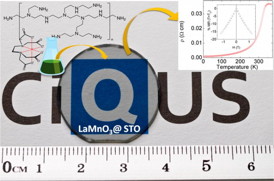Home > Press > CiQUS researchers obtain high-quality perovskites over large areas by a chemical method
 |
Abstract:
Francisco Rivadulla's Research Group reports the chemical solution (water-based) synthesis of high-quality epitaxial thin films of LaMnO3 (perovkskite) free of defects at square-centimeter scales and compatible with standard microfabrication techniques. These films show a robust ferromagnetic moment and large magnetoresistance at room temperature.
CiQUS researchers obtain high-quality perovskites over large areas by a chemical method
Santiago de Compostela, Spain | Posted on March 4th, 2015Chemical methods for thin-film deposition are an affordable and versatile alternative to physical deposition techniques (pulsed laser deposition, sputtering, molecular beam epitaxy, etc.). In particular, deposition from a solution is preferred to avoid the use of high-vacuum chambers, and, a priori, is suitable for coatings over large areas and complex-shaped objects. Among the chemical methods based on a liquid precursor, spray deposition and sol-gel are the most widely used.
However, in spite of the obvious advantages, chemical methods show some serious drawbacks, as poorer control of the thickness and stoichiometry, larger interface and surface roughness, and difficult fabrication of homogeneous films and multilayers over large areas. Consequently, these problems limited the applicability of chemical deposition methods, or their use in highly demanding applications (tunnel junctions, etc.).
In this work, Francisco Rivadulla's Group demonstrates the suitability of a chemical solution deposition method for the synthesis of high quality thin films of LaMnO3 (below 20 nm thick) at cm2 scales (1 inch diameter), cheap and compatible with standard microfabrication techniques.
LaMnO3 is a Mott insulator, an oxide which gives rise to a very rich electronic and magnetic phase diagram after hole doping, being the parent phase to colossal magnetoresistive oxides. On the other hand, it has been recently identified as one of the most suitable catalysts for electrochemical oxygen reduction reactions (fuel cells) and for the oxidative removal of toluene. Therefore, it will be very important the development of affordable techniques for deposition of LaMnO3 thin films, with a large surface/volume ratio, and free of defects over large areas. Physical properties of perovskites include superconductivity, magnetoresistance and dielectric properties, which are of great importance in microelectronics and telecommunication.
####
For more information, please click here
Contacts:
Andrés Ruiz
Communications Manager - USC Research Centers Network
Centro Singular de Investigación en Tecnoloxías da Información (CiTIUS)
Tlf: 881816411
'Campus Vida'
Universidade de Santiago de Compostela
15782 Santiago de Compostela.
SPAIN
Copyright © Universidade de Santiago de Compostela
If you have a comment, please Contact us.Issuers of news releases, not 7th Wave, Inc. or Nanotechnology Now, are solely responsible for the accuracy of the content.
| Related News Press |
Superconductivity
News and information
![]() Researchers develop molecular qubits that communicate at telecom frequencies October 3rd, 2025
Researchers develop molecular qubits that communicate at telecom frequencies October 3rd, 2025
![]() Next-generation quantum communication October 3rd, 2025
Next-generation quantum communication October 3rd, 2025
![]() "Nanoreactor" cage uses visible light for catalytic and ultra-selective cross-cycloadditions October 3rd, 2025
"Nanoreactor" cage uses visible light for catalytic and ultra-selective cross-cycloadditions October 3rd, 2025
![]() Researchers tackle the memory bottleneck stalling quantum computing October 3rd, 2025
Researchers tackle the memory bottleneck stalling quantum computing October 3rd, 2025
Wireless/telecommunications/RF/Antennas/Microwaves
![]() Researchers develop molecular qubits that communicate at telecom frequencies October 3rd, 2025
Researchers develop molecular qubits that communicate at telecom frequencies October 3rd, 2025
![]() HKUST researchers develop new integration technique for efficient coupling of III-V and silicon February 16th, 2024
HKUST researchers develop new integration technique for efficient coupling of III-V and silicon February 16th, 2024
Thin films
![]() Utilizing palladium for addressing contact issues of buried oxide thin film transistors April 5th, 2024
Utilizing palladium for addressing contact issues of buried oxide thin film transistors April 5th, 2024
Discoveries
![]() Researchers develop molecular qubits that communicate at telecom frequencies October 3rd, 2025
Researchers develop molecular qubits that communicate at telecom frequencies October 3rd, 2025
![]() Next-generation quantum communication October 3rd, 2025
Next-generation quantum communication October 3rd, 2025
![]() "Nanoreactor" cage uses visible light for catalytic and ultra-selective cross-cycloadditions October 3rd, 2025
"Nanoreactor" cage uses visible light for catalytic and ultra-selective cross-cycloadditions October 3rd, 2025
Announcements
![]() Rice membrane extracts lithium from brines with greater speed, less waste October 3rd, 2025
Rice membrane extracts lithium from brines with greater speed, less waste October 3rd, 2025
![]() Researchers develop molecular qubits that communicate at telecom frequencies October 3rd, 2025
Researchers develop molecular qubits that communicate at telecom frequencies October 3rd, 2025
![]() Next-generation quantum communication October 3rd, 2025
Next-generation quantum communication October 3rd, 2025
![]() "Nanoreactor" cage uses visible light for catalytic and ultra-selective cross-cycloadditions October 3rd, 2025
"Nanoreactor" cage uses visible light for catalytic and ultra-selective cross-cycloadditions October 3rd, 2025
Energy
![]() Sensors innovations for smart lithium-based batteries: advancements, opportunities, and potential challenges August 8th, 2025
Sensors innovations for smart lithium-based batteries: advancements, opportunities, and potential challenges August 8th, 2025
![]() Simple algorithm paired with standard imaging tool could predict failure in lithium metal batteries August 8th, 2025
Simple algorithm paired with standard imaging tool could predict failure in lithium metal batteries August 8th, 2025
Fuel Cells
![]() Deciphering local microstrain-induced optimization of asymmetric Fe single atomic sites for efficient oxygen reduction August 8th, 2025
Deciphering local microstrain-induced optimization of asymmetric Fe single atomic sites for efficient oxygen reduction August 8th, 2025
![]() Current and Future Developments in Nanomaterials and Carbon Nanotubes: Applications of Nanomaterials in Energy Storage and Electronics October 28th, 2022
Current and Future Developments in Nanomaterials and Carbon Nanotubes: Applications of Nanomaterials in Energy Storage and Electronics October 28th, 2022
|
|
||
|
|
||
| The latest news from around the world, FREE | ||
|
|
||
|
|
||
| Premium Products | ||
|
|
||
|
Only the news you want to read!
Learn More |
||
|
|
||
|
Full-service, expert consulting
Learn More |
||
|
|
||








